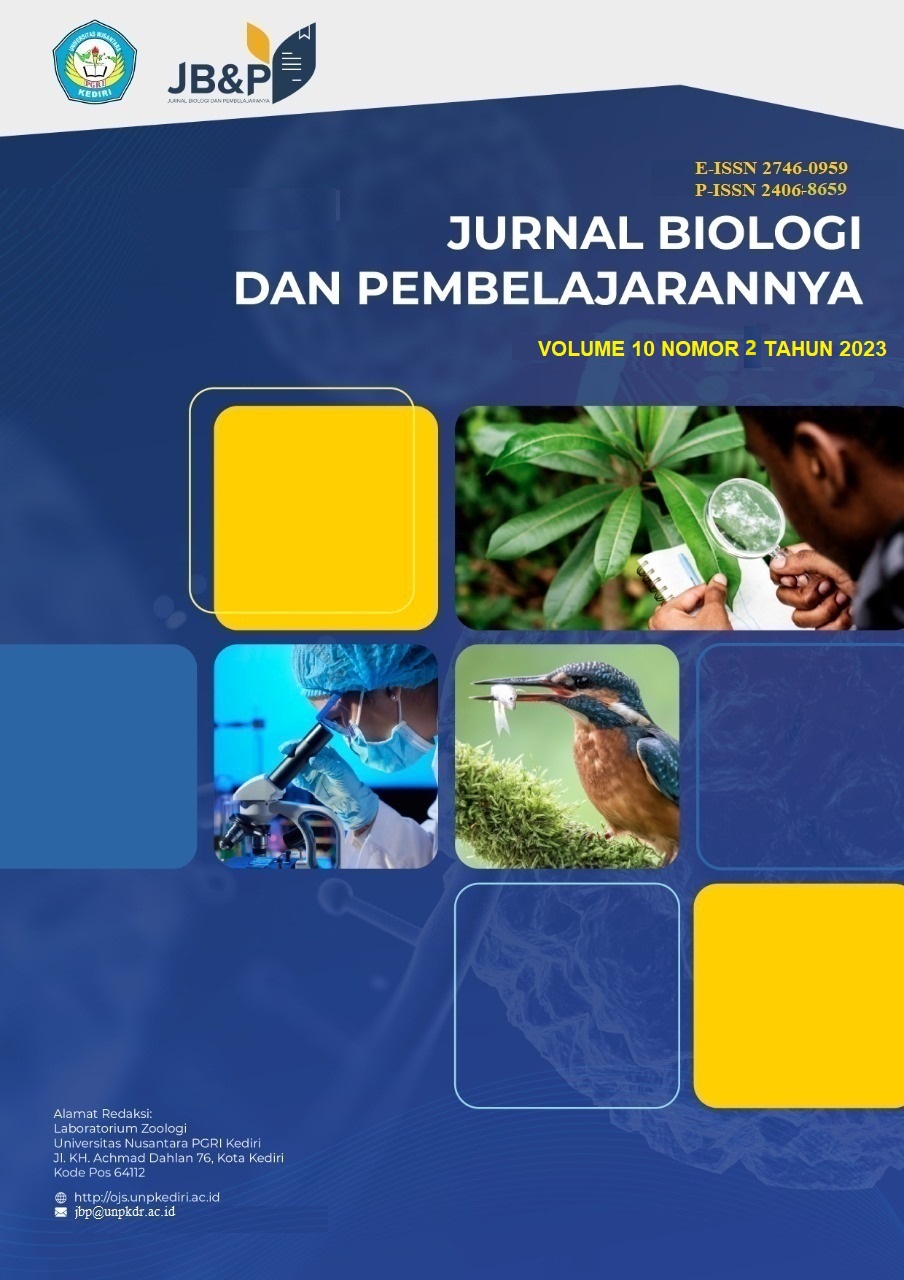Keragaman Tumbuhan Invasif di Kawasan Universitas Tadulako, Sulawesi Tengah
DOI:
https://doi.org/10.29407/jbp.v10i2.19998Keywords:
Jelajah, Tumbuhan Invasisve, Poaceae, Universitas TadulakoAbstract
Plant invasive species be attention in the world cause quite dangerous for the environment and of sorts of crops cannot compete with plants invasive. The aim of this study is to inventory invasive plants at Tadulako University. The Methods use exploration techniques to explore every area in the research sites. The results are 52 species into 23 families. Poaceae most found in every site with 9 species such as Cenchrus brownii, Chloris barbata, Chloris gayana, Dactylotenium aegyptum, Digitaria bicornis, Digitaria longiflora, Eleusene indica, Eragrotis tenela, Melenis repens. Invasive plant in Tadulako University still not be harmful for environment.
References
Abywijaya, K I., Hikmat, A., & Widyatmoko, D. (2014). Keanekaragaman dan Pola Sebaran Spesies Tumbuhan Asing Invasif di Cagar Alam Pulau Sempu, Jawa Timur. Jurnal Biologi Indonesia, 10(2), 221–235.
Handayani, A., Junaedi, D. I., & Zuhud, E. A. M. (2021). Ecological risk assessment of potentially invasive alien plant species in Cibodas Biosphere Reserve, West Java, Indonesia. IOP Conference Series: Earth and Environmental Science, 914(1), 012035. https://doi.org/10.1088/1755-1315/914/1/012035
Iqbal, M., & Hairil, H. (2020). Weed Plant in Cacao and Clove Plantations in Lakatan Village, Tolitoli Regency, Central Sulawesi. Natural Science: Journal of Science and Technology, 9(1). https://doi.org/10.22487/25411969.2020.v9.i1.15037
Ismail, S. N., Subehi, L., Mansor, A., & Mashhor, M. (2019). Invasive Aquatic Plant Species of Chenderoh Reservoir, Malaysia and Jatiluhur Reservoir, Indonesia. IOP Conference Series: Earth and Environmental Science, 380(1). https://doi.org/10.1088/1755-1315/380/1/012004
Kudo, Y., Mutaqien, Z., Simbolon, H., & Suzuki, E. (2014). Spread of invasive plants along trails in two national parks in West Java, Indonesia. Tropics, 23(3), 99–110. https://doi.org/10.3759/tropics.23.99
Lukvitasari, L., Triwidodo, H., Rizali, A., & Buchori, D. (2021). Pengaruh lokasi terhadap serangan lalat puru Cecidochares connexa (Macquart) pada tumbuhan eksotik invasif Chromolaena odorata (L.) King & Robinson dan interaksinya dengan komunitas serangga lokal. Jurnal Entomologi Indonesia, 18(2), 127–139. https://doi.org/10.5994/jei.18.2.127
McFadyen, R. E. C., De Chenon, R. D., & Sipayung, A. (2003). Biology and host specificity of the chromolaena stem gall fly, Cecidochares connexa (Macquart) (Diptera: Tephritidae). Australian Journal of Entomology, 42(3), 294–297. https://doi.org/10.1046/j.1440-6055.2003.00360.x
Nopiyanti, N., & Riastuti, R. D. (2019). Pola Sebaran Tumbuhan Invasif dikawasan Taman Nasional Bukit Sulap Kota Lubuklinggau. BIOEDUSAINS: Jurnal Pendidikan Biologi Dan Sains, 2(2), 152–159. https://doi.org/10.31539/bioedusains.v2i2.976
Rahmita, R., Ramadanil, R., & Iqbal, M. (2019). Jenis-Jenis Tumbuhan Suku Fabaceae, Subfamili Caesalpinioideae Di Areal Kampus Universitas Tadulako, Palu. Natural Science: Journal of Science and Technology, 8(2), 127–133. https://doi.org/10.22487/25411969.2019.v8.i2.13542
Rejmánek, M., & Richardson, D. M. (2013). Trees and shrubs as invasive alien species - 2013 update of the global database. Diversity and Distributions, 19(8), 1093–1094. https://doi.org/10.1111/ddi.12075
Rembold, K., Mangopo, H., Tjitrosoedirdjo, S. S., & Kreft, H. (2017). Plant diversity, forest dependency, and alien plant invasions in tropical agricultural landscapes. Biological Conservation, 213(March), 234–242. https://doi.org/10.1016/j.biocon.2017.07.020
Rugayah, Elizabeth A. Widjaja, Praptiwi. 2004, Pedoman Pengumpulan Data Keanekaragaman Flora, Bogor : LIPI.
Sunaryo; Girmansyah, D. (2015). Identifikasi tumbuhan asing invasif di Taman Nasional Tanjung Puting , Kalimantan Tengah Identification of Plants Invasive Species in Tanjung Puting National Park , Central Kalimantan . 1, 1034–1039. https://doi.org/10.13057/psnmbi/m010512
Sunaryo, Uji, T., & Tihurua, F. (2012). Komposisi Jenis dan Potensi Ancaman Tumbuhan Asing Invasif di Taman Nasional Gunung Halimun Salak, Jawa Barat. Berita Biologi, 11 (2)(2), 231–239.
Susanti, T., & Febriana, H. (2013). Keanekaragaman Tumbuhan Invasif Di Kawasan Taman Hutan Kenali Kota Jambi. 433–440.
Tjitrosoedirdjo, S. (2005). Inventory of the invasive alien plant species in Indonesia. Biotropia, (25), 60–73. Retrieved from http://journal.biotrop.org/index.php/biotropia/article/viewArticle/209
Wahyuni, I., & Tjitrosoedirdjo, S. S. (2013). Observation on the Development of Important Weeds and Invasive Alien Plant Species in Indonesia. Proceedings of the 24th Asian-Pacific Weed Science Society Conference, (September), 159–165.
Downloads
Published
Issue
Section
License
Authors who publish with this journal agree to the following terms:
- Copyright on any article is retained by the author(s).
- The author grants the journal, right of first publication with the work simultaneously licensed under a Creative Commons Attribution License that allows others to share the work with an acknowledgment of the work’s authorship and initial publication in this journal.
- Authors are able to enter into separate, additional contractual arrangements for the non-exclusive distribution of the journal’s published version of the work (e.g., post it to an institutional repository or publish it in a book), with an acknowledgment of its initial publication in this journal.
- Authors are permitted and encouraged to post their work online (e.g., in institutional repositories or on their website) prior to and during the submission process, as it can lead to productive exchanges, as well as earlier and greater citation of published work.
- The article and any associated published material is distributed under the Creative Commons Attribution-ShareAlike 4.0 International License













